Gertrude Vanderbilt Whitney
| Gertrude Vanderbilt Whitney | |
|---|---|
.jpg) circa 1909 | |
| Born |
Gertrude Vanderbilt January 9, 1875 New York City |
| Died |
April 18, 1942 (aged 67) New York City |
| Nationality | American |
| Occupation |
Sculptor Art collector |
| Spouse(s) |
Harry Payne Whitney (m. 1896; his death 1930) |
| Children |
Flora Whitney Miller Cornelius Vanderbilt Whitney Barbara Whitney Headley |
| Parent(s) |
Cornelius Vanderbilt II Alice Claypoole Gwynne |
| Relatives | See Vanderbilt family |
Gertrude Vanderbilt Whitney (January 9, 1875 – April 18, 1942) was an American sculptor, art patron and collector, and founder in 1931 of the Whitney Museum of American Art in New York City. She was a prominent social figure and hostess, who was born into the wealthy Vanderbilt family and married into the Whitney family.
Early life
.jpg)
Gertrude Vanderbilt was born in New York City January 9, 1875, the second daughter of Cornelius Vanderbilt II (1843–1899) and Alice Claypoole Gwynne (1852–1934) and a great-granddaughter of "Commodore" Cornelius Vanderbilt. Her older sister died before Gertrude was born, but she grew up with several brothers and a younger sister.[1] The family's New York City home was an opulent mansion at 742-748 Fifth Avenue.[2] As a young girl, Gertrude spent her summers in Newport, Rhode Island, at the family's summer home, The Breakers, where she kept up with the boys in all their rigorous sporting activities. She was educated by private tutors and at the exclusive Brearley School for women students in New York City.[1]
Education and early work
.jpg)
While visiting Europe in the early 1900s, Gertrude Whitney discovered the burgeoning art world of Montmartre and Montparnasse in France. What she saw encouraged her to pursue her creativity and become a sculptor.
She studied at the Art Students League of New York with Hendrik Christian Andersen and James Earle Fraser.[3][4] Other women students in her classes included Anna Vaughn Hyatt and Malvina Hoffman.[4] In Paris she studied with Andrew O'Connor[5] and also received criticism from Auguste Rodin in Paris.[6][7] Her training with sculptors of public monuments influenced her later direction.[8] Although her catalogs include numerous smaller sculptures,[3][9][10] she is best known today for her monumental works.[11]
Her first public commission was Aspiration, a life-size male nude in plaster, which appeared outside the New York State Building at the Pan-American Exposition in Buffalo, New York, in 1901.[12][13][14] Initially she worked under an assumed name, fearing that she would be portrayed as a socialite and her work not taken seriously.[4][15] Neither her family nor (after her marriage) her husband were supportive of her desire to work seriously as an artist. She once told an artist friend, "Never expect Harry to take your work seriously... It never has made any difference to him that I feel as I do about art and it never will (except as a source of annoyance)." She believed that a man would have been taken more seriously as an artist, and that her wealth put her in a lose-lose situation: criticized if she took commissions because other artists were more needy, but blamed for undercutting the market for other artists if she was not paid.[4]
In 1907, Whitney established an apartment and studio in Greenwich Village.[16] She also set up a studio in Passy, a fashionable Parisian neighborhood in the XVI arrondissement.
By 1910 she was exhibiting her work publicly under her own name.[4] Paganisme Immortel, a statue of a young girl sitting on a rock, with outstretched arms, next to a male figure, was shown at the 1910 National Academy of Design.[17] Spanish Peasant was accepted at the Paris Salon in 1911, and Aztec Fountain was awarded a bronze medal in 1915 at the San Francisco Exhibition.[4] Her first solo show occurred in New York City in 1916.[18]
World War I and its aftermath
During World War I, Gertrude Whitney dedicated a great deal of her time and money to various relief efforts, establishing and maintaining a fully operational hospital for wounded soldiers in Juilly, about 35 kilometres (22 mi) northwest of Paris in France.[18] In 1915, her brother Alfred Gwynne Vanderbilt perished in the sinking of the RMS Lusitania.
She completed a series of smaller pieces realistically depicting soldiers in wartime,[8][19] but her smaller works were not seen as particularly significant during her lifetime. Since her death critics have recognized the expert craftsmanship of her smaller works.[20]
 Chateau Thierry
Chateau Thierry His Last Charge
His Last Charge Found
Found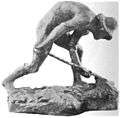 Engineers
Engineers
In addition to participating in shows with other artists, Whitney held a number of one-woman shows during her career. These included a show of her wartime sculptures at her Eighth Street Studio in November 1919;[19] a show at the Art Institute of Chicago, March 1 to April 15, 1923;[9] and one in New York City, March 17–28, 1936.[10] The Whitney museum of American art held a commemorative show of her works in 1943.[3]
Sculptures from her 1936 Show
 John
John Salome
Salome Gwendolyn
Gwendolyn Mother and Child
Mother and Child Untitled
Untitled Sketch
Sketch
Public sculptures
Following the end of the War, Whitney was also involved in the creation of a number of commemorative sculptures. During the 1920s her works received critical acclaim both in Europe and the United States, particularly her monumental works. During the 1930s the popularity of monumental pieces declined. Whitney's last pieces of public arts were the Spirit of Flight, created for the New York World's Fair of 1939,[18] and the Peter Stuyvesant Monument in New York City.[20]
Gertrude Vanderbilt Whitney's numerous works in the United States include:
- Aztec Fountain – Pan American Union Building, Washington, D.C., 1912[8]
- Fountain of El Dorado – 1915 Panama-Pacific Exposition, San Francisco, California
- Two reliefs on the Victory Arch – Madison Square, New York City, 1918–19[20][21]
- Washington Heights-Inwood War Memorial (World War I) – Mitchell Square Park, Washington Heights, New York City, erected 1922[22]
- Buffalo Bill - The Scout, William F. Cody Memorial – Cody, Wyoming, dedicated 1924
- Untermyer Memorial, Woodlawn Cemetery, New York City, 1925[23]
- The Founders of the Daughters of the American Revolution, a memorial honoring the four founders – Constitution Hall, Washington, D.C., dedicated 1929; Gertrude was a member of the DAR.[24][25]
- Women's Titanic Memorial – Washington, D.C., unveiled 1931[26]
- Peter Stuyvesant Monument, New York City, 1936–1939
- To the Morrow, vt. Wings, vt. Spirit of Flight,[3] created for the World's Fair in New York, 1939[27]
- Victory Arch, one of two bronze reliefs, New York City
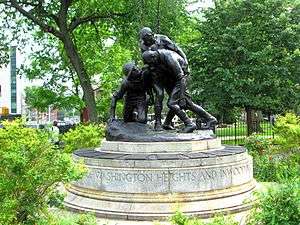 Washington Heights-Inwood War Memorial (World War I), New York City
Washington Heights-Inwood War Memorial (World War I), New York City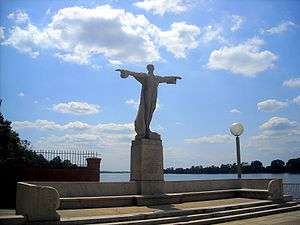 Women's Titanic Memorial, Washington, D.C.
Women's Titanic Memorial, Washington, D.C. Buffalo Bill - The Scout, Cody, Wyoming
Buffalo Bill - The Scout, Cody, Wyoming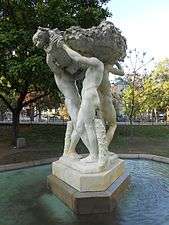
- Founders of the Daughters of the American Revolution, Washington, D.C.
- A.E.F. Memorial, Saint-Nazaire, France
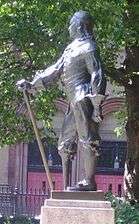 Peter Styvesant, New York City
Peter Styvesant, New York City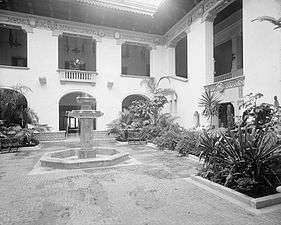 Aztec fountain, Pan American Union Building, Washington, D.C.
Aztec fountain, Pan American Union Building, Washington, D.C.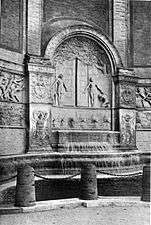 Fountain of El Dorado, detail, 1915 Panama-Pacific Exposition
Fountain of El Dorado, detail, 1915 Panama-Pacific Exposition
Whitney also created works which are now in other countries, including the A.E.F. Memorial in St. Nazaire Harbor in Saint-Nazaire, France, 1924.[28] The Government of France purchased a marble replica of the head of the Titanic memorial which is now housed in the Musée du Luxembourg.
Whitney sculpted the Christopher Columbus memorial, called "Monumento a la Fe Descubridora" (Monument to the Discovery Faith), in Huelva, Spain, 1928–33. With a cubist style, it is one of her biggest works.
In 1931 Whitney presented the Caryatid Fountain to McGill University in Montreal, Canada,. The fountain is also referred to as The Good Will Fountain, The Friendship Fountain, The Whitney Fountain, The Three Graces and because it consists of three nude males, The Three Bares..[29] There is also a bronce version of this fountain in the Washington Square in Lima, Peru[30]
Influence in art

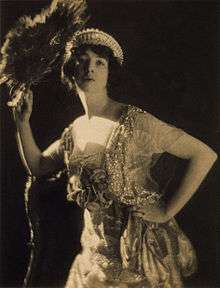
Her great wealth afforded her the opportunity to become a patron of the arts, but she also devoted herself to the advancement of women in art, supporting an exhibiting in women-only shows and ensuring that women were included in mixed shows.[31] She supported exhibition of artwork both locally and around the country, including the 1913 Armory Show in New York.[32] She actively bought works from new artists including the Ashcan School.[18] In 1922, she financed publication of The Arts magazine, to prevent its closing.[18] She was the primary financial backer for the "International Composer's Guild," an organization created to promote the performance of modern music.[33]
By 1908, Whitney had opened the Whitney Studio Gallery in the same buildings as her own studio on West Eighth Street in Greenwich Village. Artists such as Robert Henri and Jo Davidson were invited to showcase their works there.[34] In 1914, Gertrude Whitney also established the Whitney Studio Club at 147 West 4th Street, as an artists' club where young artists could meet and talk, as well as exhibit their works.[7] The Whitney Studio Club expanded again when its headquarters were moved back from West Fourth Street to West Eighth Street in 1923.[35] Thus, the club expanded both in size and scope of programming. These early galleries would evolve to become Whitney's greatest legacy, the Whitney Museum of American Art, on the site of what is now the New York Studio School of Drawing, Painting and Sculpture. Founded in 1931, Whitney decided to create her own museum after the New York Metropolitan Museum of Art turned down her offer to give it her twenty-five-year collection of nearly 700 modern art works.
A colorful recollection of one of her parties celebrating her artist friends was recounted by the artist Jerome Myers:
"Matching it in memory is a party at Mrs. Gertrude Vanderbilt Whitney's, on her Long Island estate, the artists there a veritable catalog of celebrities, painters and sculptors. I can hardly visualize, let alone describe, the many shifting scenes of our entertainment: sunken pools and gorgeous white peacocks as line decorations spreading into the gardens; in their swinging cages, brilliant macaws nodding their beaks at George Luks as though they remembered posing for his pictures of them; Robert Chanler showing us his exotic sea pictures, blue-green visions in a marine bathroom; and Mrs. Whitney displaying her studio, the only place on earth in which she could find solitude. Here the artists felt at home, the Whitney hospitality always gracious and sincere."[36]
Her Greenwich Village studio has been named a National Treasure by the National Trust for Historic Preservation, giving it landmark status.[37]
Personal life
At age 21, on August 25, 1896, Gertrude married the extremely wealthy sportsman Harry Payne Whitney (1872–1930).[1][8] A banker and investor, Whitney was the son of William Collins Whitney, and his mother, the former Flora Payne, was the daughter of a U.S. Senator and sister of a Standard Oil Company magnate. Harry Whitney inherited a fortune in oil and tobacco as well as interests in banking.[38] In New York, the couple lived in town houses originally belonging to William Whitney, first at 2 East 57th St., across the street from Gertrude's parents, and after William Whitney's death, at 871 Fifth Avenue.[39] They also had a country estate in Westbury, Long Island.[8] Gertrude and Harry Whitney had three children:
- Flora Payne Whitney (1897–1986)
- Cornelius Vanderbilt Whitney (1899–1992)
- Barbara Whitney (1903–1983, m. 1960 George W. Headley).[38]
Harry Whitney died of pneumonia in 1930, at age 58, leaving his widow an estate valued at $72 million.[40] In 1934, she was at the center of a highly publicized court battle with her sister-in-law, Gloria Morgan Vanderbilt, for custody of her ten-year-old niece, Gloria Vanderbilt.
Gertrude Whitney died in 1942, at age 67, and was interred next to her husband in Woodlawn Cemetery in The Bronx, New York City.[41] Her daughter Flora Whitney Miller assumed her mother's duties as head of the Whitney Museum, and was succeeded by her daughter, Flora Miller Biddle.[42]
Awards and honors
- Medal of Award at Panama-Pacific Exhibition for Fountain of El Dorado, 1915[20][43]
- Associate member of National Sculpture Society, 1916[43]
- Medal from the New York Society of Architects for the Mitchel Square World War I memorial, 1923
- Honorary degree, New York University, 1922[44]
- Honorary degree, Tufts University, 1924[44]
- Bronze medallion at Paris Salon for Buffalo Bill - The Scout, 1924[43]
- French Legion of Honor medal, 1926[43]
- Honorary degree, Rutgers University, 1934[44]
- Elected an honorary member of the American Institute of Architects, 1934[20]
- Honorary degree, Russell Sage College, 1940[44]
- Associate of National Academy of Design, 1940[44]
- Medal of Honor of the National Sculpture Society, 1940[43]
In popular culture
In the 1982 tele-film, Little Gloria...Happy At Last, Whitney was portrayed by actress Angela Lansbury, who earned an Emmy nomination for her performance.
In 1999, Gertrude Whitney's granddaughter, Flora Miller Biddle, published a family memoir entitled The Whitney Women and the Museum They Made. She was also the subject of B. H. Friedman's 1978 Gertrude Vanderbilt Whitney: A Biography.[45]
Ancestry
| Ancestors of Gertrude Vanderbilt Whitney | ||||||||||||||||||||||||||||||||||||||||||||||||||||||||||||||||||||||||||||||||||||||||||||||||||||||||||||||||||||||||||||||||||||||||||||||||||||||||||||||||||||||||||||||||||||||||||||||||||||||||||||||||||||||||||||||||||||||||||||||||||||||||||||||||||||||||||||||||||||||||||||||||||||||||||||||||||||||||||||||||||||||||||||||||||||||||||||||||||||||||||||||||||||||||||||||||||||||||||||||||||||||||||||||||||||||||||||||||||||||||||||||||||||||||||||||||||||||||||||||||||||||||||||
|---|---|---|---|---|---|---|---|---|---|---|---|---|---|---|---|---|---|---|---|---|---|---|---|---|---|---|---|---|---|---|---|---|---|---|---|---|---|---|---|---|---|---|---|---|---|---|---|---|---|---|---|---|---|---|---|---|---|---|---|---|---|---|---|---|---|---|---|---|---|---|---|---|---|---|---|---|---|---|---|---|---|---|---|---|---|---|---|---|---|---|---|---|---|---|---|---|---|---|---|---|---|---|---|---|---|---|---|---|---|---|---|---|---|---|---|---|---|---|---|---|---|---|---|---|---|---|---|---|---|---|---|---|---|---|---|---|---|---|---|---|---|---|---|---|---|---|---|---|---|---|---|---|---|---|---|---|---|---|---|---|---|---|---|---|---|---|---|---|---|---|---|---|---|---|---|---|---|---|---|---|---|---|---|---|---|---|---|---|---|---|---|---|---|---|---|---|---|---|---|---|---|---|---|---|---|---|---|---|---|---|---|---|---|---|---|---|---|---|---|---|---|---|---|---|---|---|---|---|---|---|---|---|---|---|---|---|---|---|---|---|---|---|---|---|---|---|---|---|---|---|---|---|---|---|---|---|---|---|---|---|---|---|---|---|---|---|---|---|---|---|---|---|---|---|---|---|---|---|---|---|---|---|---|---|---|---|---|---|---|---|---|---|---|---|---|---|---|---|---|---|---|---|---|---|---|---|---|---|---|---|---|---|---|---|---|---|---|---|---|---|---|---|---|---|---|---|---|---|---|---|---|---|---|---|---|---|---|---|---|---|---|---|---|---|---|---|---|---|---|---|---|---|---|---|---|---|---|---|---|---|---|---|---|---|---|---|---|---|---|---|---|---|---|---|---|---|---|---|---|---|---|---|---|---|---|---|---|---|---|---|---|---|---|---|---|---|---|---|---|---|---|---|---|---|---|---|---|---|---|---|---|---|---|---|---|---|---|---|---|---|---|---|---|---|---|---|---|---|---|---|---|---|---|---|---|---|---|---|---|---|---|---|---|---|---|---|---|---|---|---|---|---|---|---|---|---|---|---|---|---|---|---|---|---|---|---|---|---|---|---|---|---|---|---|---|---|---|---|---|---|---|---|---|---|---|---|---|---|---|---|---|---|
| ||||||||||||||||||||||||||||||||||||||||||||||||||||||||||||||||||||||||||||||||||||||||||||||||||||||||||||||||||||||||||||||||||||||||||||||||||||||||||||||||||||||||||||||||||||||||||||||||||||||||||||||||||||||||||||||||||||||||||||||||||||||||||||||||||||||||||||||||||||||||||||||||||||||||||||||||||||||||||||||||||||||||||||||||||||||||||||||||||||||||||||||||||||||||||||||||||||||||||||||||||||||||||||||||||||||||||||||||||||||||||||||||||||||||||||||||||||||||||||||||||||||||||||
Titles from birth to death
- 1875-1896: Miss Gertrude Vanderbilt
- 1896-1930: Mrs. Harry Payne Whitney
- 1930-1942: Mrs. Gertrude Whitney
References
- 1 2 3 Vanderbilt, Arthur T., II (August 1989). Fortune's Children: The Fall of the House of Vanderbilt. New York: Morrow. ISBN 0-688-07279-8. Retrieved December 17, 2014.
- ↑ Waldman, Benjamin. "Then and Now: Remnants of the Vanderbilt Mansion in New York City". Untapped Cities. Retrieved December 27, 2014.
- 1 2 3 4 Memorial exhibition; Gertrude Vanderbilt Whitney. New York: Whitney museum of American art. 1943. Retrieved December 27, 2014.
- 1 2 3 4 5 6 McCarthy, Kathleen D. (1991). Women's culture : American philanthropy and art, 1830-1930. Chicago: University of Chicago Press. p. 221. ISBN 9780226555843. Retrieved December 28, 2014.
- ↑ Opitz, Glenn B, Editor, Mantle Fielding's Dictionary of American Painters, Sculptors & Engravers, Apollo Book, Poughkeepsie NY, 1986
- ↑ Friedman, B.H., Gertrude Vanderbilt Whitney, Doubleday and Company New York, 1978
- 1 2 "The Whitney Museum of American Art". The Art Story.org. Retrieved December 27, 2014.
- 1 2 3 4 5 Magill, Frank N., ed. (1999). "Gertrude Vanderbilt Whitney". Dictionary of world biography. Chicago: Fitzroy Dearborn. pp. 3969–3971. ISBN 1579580483. Retrieved December 27, 2014.
- 1 2 Exhibition of sculpture by Gertrude V. Whitney of New York : March 1 to April 15, 1923. Chicago: Art Institute of Chicago. 1923.
- 1 2 Sculpture by Gertrude V. Whitney : [exhibition], March 17 through 28, 1936. M. Knoedler and Co. 1936. Retrieved December 28, 2014.
- ↑ Marter, Joan (2000). "Whitney, Gertrude Vanderbilt". American National Biography Online. Oxford University Press. Retrieved December 28, 2014.
- ↑ "Pan-American Exposition Sights - Then & Now". Western New York Heritage Press. Retrieved February 4, 2015.
- ↑ "Gertrude Vanderbilt Whitney". "Doing the Pan". Retrieved February 4, 2015.
- ↑ Heller, Jules; Heller, Nancy G. (1995). North American women artists of the twentieth century : a biographical dictionary. New York: Garland Publishing. p. 577. ISBN 9780815325840. Retrieved February 4, 2015.
- ↑ Staples, Shelley. ""The Part Played By Women:" The Gender of Modernism at the Armory Show". American Studies Program. University of Virginia. Retrieved 2001. Check date values in:
|access-date=(help) - ↑ "Gertrude Vanderbilt Whitney papers, 1851-1975, bulk, 1888-1942". Archives of American Art. Retrieved February 4, 2015.
- ↑ Love, Richard H. (1999). Carl W. Peters : American scene painter from Rochester to Rockport. Rochester, NY: University of Rochester Press. p. 164. ISBN 9781580460248.
- 1 2 3 4 5 Grimm, Jr., Robert T. (2002). Notable American philanthropists : biographies of giving and volunteering. Westport, Conn.: Greenwood Press. pp. 341–344. ISBN 978-1573563406. Retrieved February 4, 2015.
- 1 2 Roberts, Mary Fanton (1919). "Sculpture of War: The Work of Gertrude V. Whitney". The Touchstone and the American art student magazine. 6: 188–194.
- 1 2 3 4 5 Marter, Joan (2011). The Grove encyclopedia of American art. Oxford: Oxford University Press. pp. 212–214. ISBN 9780195335798. Retrieved December 27, 2014.
- ↑ Capraro, Douglas. "Daily What?! The Flatiron's Mysterious "Victory Arch" at Madison Square Park". Untapped Cities. Retrieved December 27, 2014.
- ↑ "Mitchel Square Washington Heights-Inwood War Memorial". NYC Parks. New York City Department of Parks & Recreation. Retrieved December 27, 2014.
- ↑ Meier, Allison. "From Da Bronx to Eternity". Hypoallergenic (Blog). Retrieved July 3, 2012.
- ↑ "Founders Memorial". Daughters of the American Revolution. Retrieved October 31, 2014.
- ↑ "Daughters of the American Revolution, Founders statue at Constitution Hall in Washington, D.C.". DC Memorials. April 20, 2013. Retrieved December 17, 2014.
- ↑ Hanson, Jayna. "Titanic, an Unsinkable Legacy: Part I, Gertrude Vanderbilt Whitney's Titanic Memorial and Francis Davis Millet in the Archives of American Art". Archives of American Art Blog. Retrieved April 11, 2012.
- ↑ "Art - Sculpture - To the Morrow (Gertrude Vanderbilt Whitney)". NYPL Digital Gallery. Retrieved December 27, 2014.
- ↑ McAuliffe, John. "St. Nazaire, France Memorial". 87th Infantry Division Photo Galleries. Retrieved December 27, 2014.
- ↑ The Good Will Fountain, The Friendship Fountain, The Whitney Fountain, as well as The Three Graces.
- ↑ Bicketts, Mónica (1988). Lima, paseos por la ciudad y su historia. Lima: Diario Expreso.
- ↑ "Whitney, Gertrude Vanderbilt (1875–1942)". Women in World History: A Biographical Encyclopedia. Encyclopedia.com. Retrieved February 4, 2015.
- ↑ Shircliff, Jennifer Pfeifer (May 2014). Women of the 1913 Armory Show: Their Contributions to the Development of American Modern Art. Louisville, Kentucky: University of Louisville. Retrieved November 15, 2014.
- ↑ Locke, Ralph P., ed. (1997). Cultivating music in America : women patrons and activists since 1860. Berkeley: Univ. of California Press. pp. 239–241. ISBN 9780520083950. Retrieved February 4, 2015.
- ↑ Whitney Museum of American Art (1937). Whitney Museum of American Art: history, purpose and activities, with a complete list of works in its permanent collection to June, 1937. New York: Whitney Museum of American Art. p. 3. Retrieved February 7, 2015.
- ↑ Richmond, Lauren (2014). Defining the American Vision: The Whitney Museum of American Art's role in changing the landscape of American art history. Wellesley College Honors Thesis Collection. Retrieved February 10, 2015.
- ↑ Myers, Jerome (1940). Artist In Manhattan. New York: American Artist Group, Inc. p. 61.
- ↑ Cascone, Sarah (October 8, 2014). "Landmark Designations for Whitney and Wyeth Studios". ArtNet News. Retrieved February 4, 2015.
- 1 2 "Gertrude Vanderbilt Whitney [1875-1942]". New Netherland Institute. Retrieved December 17, 2014.
- ↑ Adams, Michael Henry. "The Most Palatial House in New York: Stanford White's William Collins Whitney Residence!". Michael Henry Adams, Style and Taste!. Retrieved December 27, 2014.
- ↑ Vanderbilt, 354.
- ↑ "Mrs. H.P. Whitney, Sculptor, Is Dead". The New York Times. April 18, 1942. Retrieved December 17, 2014.
- ↑ Howe, Marvine (July 19, 1986). "Flora Whitney Miller Is Dead". The New York Times. Retrieved December 17, 2014.
- 1 2 3 4 5 Commire, Anne; Klezmer, Deborah, eds. (1999). "Whitney, Gertrude Vanderbilt (1875–1942)". Women in world history : a biographical encyclopedia. Waterford, Conn.: Yorkin Publishers. ISBN 0787640808. Retrieved December 27, 2014.
- 1 2 3 4 5 James, Edward T.; James, Janet Wilson; Boyer, Paul S., eds. (1974). Notable American women, 1607-1950 : a biographical dictionary (3. print. ed.). Cambridge, Mass.: Belknap Press of Harvard University Press. pp. 601–603. ISBN 0674627342. Retrieved December 27, 2014.
- ↑ Weber, Bruce (January 10, 2011). "B. H. Friedman, a Novelist, Art Critic and Pollock Biographer, Is Dead at 84". The New York Times. Retrieved January 11, 2011.
External links
| Library resources about Gertrude Vanderbilt Whitney |
| By Gertrude Vanderbilt Whitney |
|---|
| Wikisource has the text of a 1920 Encyclopedia Americana article about Gertrude Vanderbilt Whitney. |
 Media related to Gertrude Vanderbilt Whitney at Wikimedia Commons
Media related to Gertrude Vanderbilt Whitney at Wikimedia Commons- Gertrude Vanderbilt Whitney Papers at the Smithsonian's Archives of American Art
- Gertrude Vanderbilt Whitney's descendants
- Gertrude Vanderbilt Whitney; findagrave.com